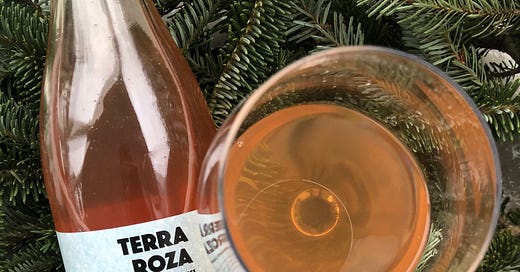Orange Wine is the Sipping Adventure You Need Right Now
Four to try from this exciting, evolving wine category
It’s time for a change in scenery. Beyond the main wine categories we know and love — i.e. red, white, rosé, and sparkling — there’s fresh terrain waiting to be explored in orange wine.
Why do I think you’ll enjoy these wines? Right now, we could all use some excitement. Something fun to spice up our at-home existences, which are tolerable at best. (Case in point: I changed out of yoga pants for the first time in weeks to “dress up” in jeans for an errand. You can’t see me grimacing, but it’s there — this is what it’s come to, sigh.)
But back to adventure! Think of orange wines like a ski resort. There are easy green and blue runs that everyone will enjoy, and black diamonds that are more challenging. Same with orange wines, which run the gamut stylistically — some are crowdpleasers, others are … less so.
What’s most exciting about these wines is that they’re whites that drink like reds. They have texture, weight, and tea-like grip (tannins). And bold flavors (dried fruit + spices), making them ideal for cold-weather sipping — and for pairing with spiced and spicy foods.
What to know
Orange wines drink like reds because they’re made like reds. Instead of separating grape skins from the juice after the grapes are pressed (standard for whites), the juice is left on the skins and seeds, sometimes for days or weeks, to gain color and tannins (the tea-like grip) that comes from the grape skins and seeds. You’ll often see orange wines described as “skin fermented” for this reason.
The result is deeply flavored wines that are totally unique. Typically, you’ll get white wines flavors that are dialed up to 10. Depending on the grapes used, that often means fruit (apples + peaches), flowers (jasmine + honeysuckle), and flavors of honey or beeswax, although the wines are totally dry. That’s accompanied by tea-like flavors (oolong + orange spice) and sensations (drying astringency + weightiness).
As for pairings, orange wines are super versatile. I once took this Gravner Ribolla Gialla to a BYOB Peking duck dinner with some wine study buddies, and we all flipped out. It was an unexpectedly delicious pairing — the wine’s bold flavors and weight complementing the crackly duck and its accompaniments perfectly. I also love orange wines with Thai food, mezze platters (falafel, hummus, baba ganoush), nutty salads (or really, any salads), and cheese and charcuterie boards.
And while it might sound like these wines are a hipster fad, that couldn’t be further from the truth. Orange wines have been made for more than 8,000 years, with early examples produced in the country of Georgia, using clay amphoras that were buried in the ground for temperature control. Today, that technique is being used worldwide to ferment and age wines, and one winemaker is even making these massive clay vessels himself.
Four to try
To get you set for your own sipping adventure, I tasted through nearly a case of orange wines, and am sharing my top picks here. I rated these wines like ski hills, based on their “difficulty” level. If this is your first time trying an orange wine, stick with green or blue. But if you’re up for an epic adventure, go black diamond.
GREEN CIRCLE
Borgo Savaian “Aransat” 2019 ($19)
“Aransat” (Friulian slang for “orange”) is made in the mountainous Friuli region of Italy, at a small family winery. Third-generation winemaker Nicola Biasi focuses on indigenous varieties, which are farmed sustainably. This is a gluggable, copper colored wine made from Sauvignon Blanc and Pinot Grigio. It starts out with dried citrus and warm spice aromas and moves into flavors of stone fruit (peach + nectarine) and citrus-spiced black tea, with the texture and weight of iced tea.
Garalis Terra Roza 2019 ($22)
This is a crowd-pleasing, copper-colored wine. I served it with a holiday turkey dinner, all the trimmings, and everyone loved it. It comes from one of my favorite natural Greek importers, Eklektikon, which brings the wines of tiny producers — like third-generation organic grower Manolis Garalis — to market. On the nose, there’s citrus zest (lemon + grapefruit) and spice, and in a sip, you’ll find juicy fruit (cherries + berries) and spice (orange spiced tea + black pepper).
BLUE SQUARE
Pittnauer ‘Perfect Day’ 2019 ($27)
Gerhard Pittnauer is a biodynamic producer in Austria who makes beautiful natural wines. This pale gold blend features Chardonnay, Muscat, Gruner Veltliner, and Traminer. It’s an easy drinking, crisp orange wine with a touch of tea-like astringency. Aromas of orange blossom and nutmeg are followed on a sip by tart, juicy citrus (grapefruit + lemon) and stony minerality.
BLACK DIAMOND
Channing Daughters “Ramato,” 2019 ($24)
In the Friuli region of Italy, “Ramato” refers to a the historic practice of fermenting Pinot Grigio wines on their skins to yield a coppery hue. This wine is made on Long Island, in New York, by winemaker Christopher Tracy, who makes dozens of interesting small batch wines (here’s a list). This wine is such a pleasure to sip. It’s deeply aromatic, with dried fruit (apricot + pear), honey, citrus, and baking spices. What stands out though, is the complexity. On sipping, it’s dry with mouthwatering acidity. There are layers of flavors (orange peel + coriander) and texture (beeswax + black tea astringency) and weightiness that evolve in an unexpected and compelling way.




